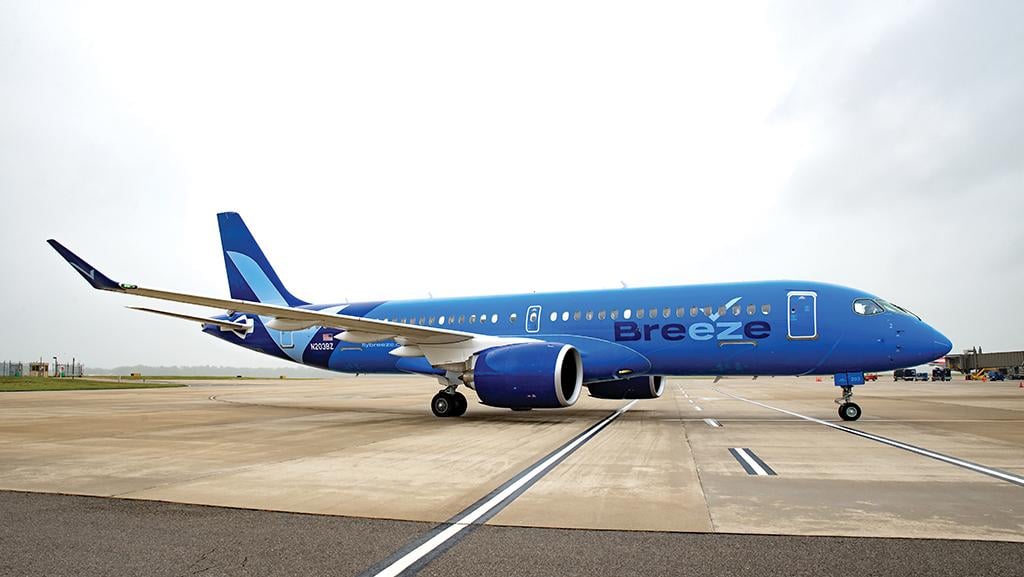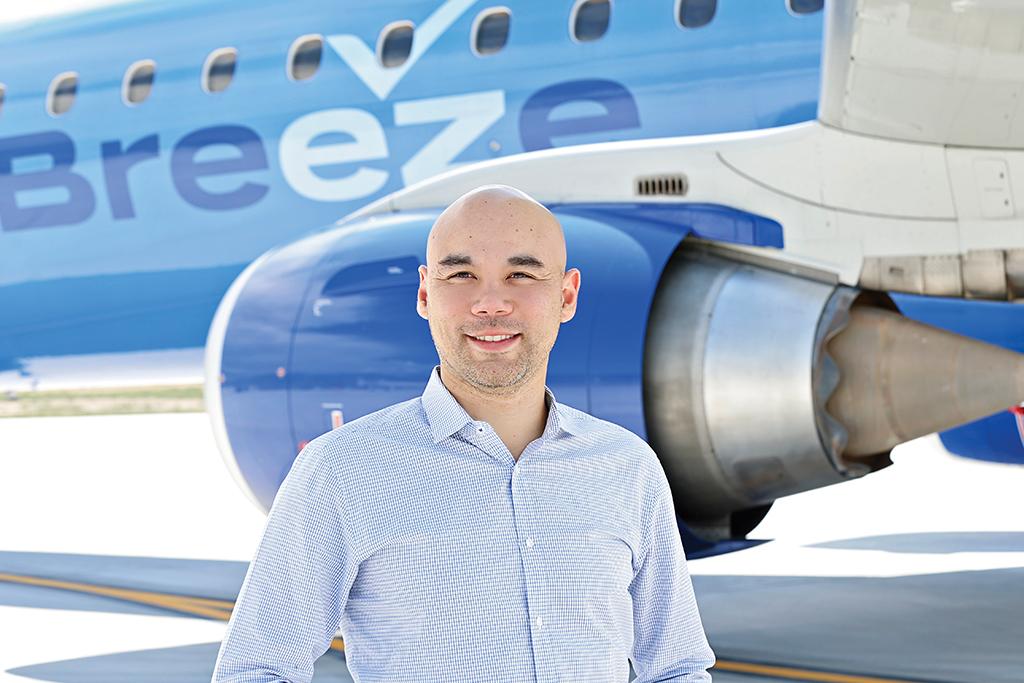
Breeze has been built around the unique capabilities of the Airbus A220.
Eighteen months after launching on May 27, 2021, Breeze Airways is sailing into its next phase of growth. The high-profile David Neeleman startup is confronting a mix of headwinds and tailwinds. Provo, Utah-based Breeze was the most privately capitalized airline startup, attracting $287 million in three rounds of financing leading up to its launch.
- Operational and financial hurdles marked the carrier’s first year
- Regional markets may offer opportunities
With its contrarian founder and business model, the ultra-low-cost carrier (ULCC) could be considered the un-ULCC. Market-stimulating low fares and low costs are about all Breeze has in common with other cost-cutting carriers. “Breeze is a tech company that happens to fly airplanes,” Neeleman says. The company’s bundled approach to segmentation with its “Nice,” “Nicer” and “Nicest” branded fares; large premium cabin offering for the price of economy class; and a digital-only approach to reservations, merchandising and customer service are just a few ways in which the company is a disruptor as much as it is a discounter.
Breeze Chief Commercial Officer Lukas Johnson tells Aviation Week that the original premise of the airline remains the same. “We built the airline around a unique plane [the Airbus A220] that gives us unique opportunities,” he asserts. The A220 is able to connect small and medium-size cities with larger city-pairs, particularly on long/thin routes such as transcontinental ones, that have never had that service before. The vast majority of Breeze’s hub-bypassing, point-to-point nonstops have had no direct competition.
Germinating before and during the pandemic, the airline has faced many unexpected challenges, Johnson concedes, such as the higher-priced, tighter labor environment—particularly for pilots—and supply chain issues. It is “the stuff everyone is facing,” he says. Slower deliveries of the U.S.-built A220s and some quality control issues with the aircraft have also been constraints.
But ever the opportunistic contrarian, Breeze is benefiting from major carriers’ shift away from regional flying, which plays right into its sweet spot. “In 2022, regional departures were lower than mainline departures at the legacies for the first time ever,” Johnson notes. “That elimination and reduction of service to smaller communities gives us the potential to stimulate new demand that’s higher even than before. The fares are up significantly, and for the traveling public that’s trying to get between two midsize cities, there’s just not as many options.”
He points to transcontinental and longer-haul connectivity to Los Angeles, San Francisco, Las Vegas and Phoenix from smaller markets that have never had such services, such as Akron, Ohio; Charleston, South Carolina; Fort Myers, Florida; Hartford, Connecticut; Providence, Rhode Island; and Richmond, Virginia. These routes have proven to be the most successful, with Hartford and Charleston leading the pack. Adding secondary airports in densely populated areas such as Westchester County and Long Island, New York, and Provo south of Salt Lake City is proving to be another rich opportunity.
The company is constantly finding riches in exploring niches: It is acquiring slots at airports that have never seen domestic long-haul and transcontinental service, such as the fast-growing Los Angeles exurb of San Bernadino, and “high-end” leisure areas that have lost services, such as Vero Beach, which is about equidistant from Daytona Beach, Orlando and West Palm Beach, Florida.

However, some high-profile routes were dropped shortly after they launched, and some were canceled before services began. Johnson says this had more to do with long-haul pilot and aircraft availability than lack of demand. The network has had other misfires as well. But Breeze seems to follow the classic tech mantra: “Fail fast and move on.” “Most of our network has had some sort of reduction,” Johnson says. Breeze has pulled out of cities such as San Antonio and Oklahoma City altogether. OAG data shows that the carrier has served 127 airport pairs in total, and 83 are scheduled for March.
“We have absurd growth plans of a 200% increase in capacity for 2023,” Johnson discloses. The current route map has 119 nonstop routes between 35 cities in 20 states. A spokesman confirms that the addition of more than 20 inaugural routes is planned in the first quarter of this year and then “a bunch more in May.”
Expansion of international and Extended-range Twin-Engine Operations Performance Standards flights, a cornerstone of Breeze’s business plan, is slated for 2024. “Our plan right now is to be flag-certified by the FAA and to get the necessary government approvals this year,” Johnson says.
To power this rapid-fire growth, the company expects to take delivery of close to one A220 per month toward fulfilling its orderbook of 80 airframes in addition to the 11 it has already received. By the end of 2023, the fleet is projected to number about 40, including used, smaller-gauge secondhand Embraer E-Jets to augment the 14 used for shorter-haul, low-utilization flying and the company’s busy charter schedule.
Breeze employs 1,112 people and plans to have seven bases up and running by March, including at Charleston, Hartford, New Orleans, Providence, Provo and Tampa, Florida.
The climb out has not been without bumps, however. Airline industry news website Enilria.com pored over Breeze’s Transportation Department filings, and its report did not paint a pretty financial picture. Enilria says the filings show a negative 110% margin with a $37.9 million loss on $34.5 million revenues and $72.3 million in expenses in the third quarter of 2022.
“The revenue is staggeringly low,” Enilria wrties. “It cost Breeze $2.10 in expenses for every $1 of revenue. They have an Everest-sized mountain to climb by comparison, based on their own financial reporting.” Enilria also notes that “Breeze’s fuel bill alone has used up 60% of all their revenue in [the first three quarters of] 2022.”
Johnson is not disclosing additional financial details of the private company, but he says actual yields are above plan and exceed those of other LCCs. “We benchmark a lot, and the markets that have been running over 12 months are now well over our projections,” he notes. Breeze says it has served 1.6 million passengers since its launch in May 2013, with the millionth guest emplaned last September. After a sluggish start, load factors improved to a systemwide average of 80%, Johnson says, adding that forward booking indicates they should continue to improve.
FlightAware data identifies operational struggles as well. In fiscal 2022, Breeze canceled 473 flights out of 14,683, or 3.2%, and 34.7% of flights were delayed for 64 min. on average. “We certainly have had our share of delays,” Johnson admits. He attributes some of the issues to weather, small airports and the immaturity of the carrier’s network optimization. “Process improvement is a big focus for us for 2023,” he says.
The operational news is not entirely bleak, however. Johnson points out that last summer, “when everyone was canceling, we went 49 days without a single one.” Operational performance has continued to improve, too. Over the Christmas-New Year holiday period, Breeze canceled just two flights, and 24% were delayed for an average of 46 min. in the fourth quarter of last year, according to FlightAware.
Despite the teething pains, Breeze was named second-best domestic airline by Travel and Leisure magazine. Johnson says the company is enjoying high guest satisfaction scores, particularly for its onboard product and the value proposition of flexibility.
Pilot constraints have presented operational and fleet utilization headwinds, but brighter prospects are forecast with the opening of the airline’s own flight-training academy, which is planned to make use of Breeze’s own Airbus A220 and E-Jet simulators. ”We’ve got enough pilots hired. It’s just about getting [them] through the pipeline,” Johnson says.
Out-of-the-box innovative ideas have been in Breeze’s DNA since the beginning, but not all ideas are or were expected to be winners. Some of the more unorthodox innovations—such as the flight attendant recruiting program under which attendants in training were paid partially in college tuition and room and board while working toward a college degree partnership with Utah State University—have not worked out exactly as planned. Although the program remains, Breeze is engaging in more traditional recruiting, too.
Similarly, the airline is shifting from the original A220 layout with 36 premium seats, which raised eyebrows when first announced, to a denser 137-seat configuration. “We settled on a more normalized premium cabin of 12 first-class [Nicest], 45 extra-leg-room [Nicer] and 80 standard-legroom seats [Nice],” Johnson says. Breeze is capturing demand for premium seats, he notes, and configurations with a greater number of premium seats are more fitting for longer flights, such as planned eventual operations to Brazil and Europe for which passengers would be willing to pay more. While Neeleman’s concept of a convertible configuration is feasible, it is on the back burner for now.
Breeze has billed itself as “The Nice Airline,” so many were caught off guard when the company adopted an e-commerce customer service approach, interacting with passengers via email, WhatsApp, Facebook Messenger, social media or the airline’s website. “We’ve got everybody who makes a booking creating a user account and log-in, which is unique in [the] industry,” Johnson says. “So if you’re chatting with our guest empowerment team, it’s going to be to one, unified source, which is really a much better experience. We don’t have all these horror stories about waiting on the phone for 18 hr.”
The carrier touts its app as the epicenter of a guest’s travels that uses data and artificial intelligence to offer services down to restaurant reservations and attractions unique to the user’s itinerary and profile. “The current app’s slick functionality blows away everybody else’s,” Johnson asserts. But he admits that further development is needed to realize these ambitions. “You’re not going to be as established as some of the airlines that have spent a billion dollars because you’re a startup,” he says. “But our team is very fast and nimble.”
No one can predict which way Breeze’s winds will ultimately blow, and Johnson projects bullishness but admits that the carrier is a work in progress. “People just have to realize in a startup world, you’re going to have a significant ramp up,” he says.





